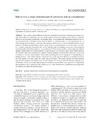Identificador persistente para citar o vincular este elemento:
https://accedacris.ulpgc.es/jspui/handle/10553/75419
| Título: | Behavior is a major determinant of predation risk in zooplankton | Autores/as: | Almeda, Rodrigo van Someren Gréve H Kiørboe T |
Clasificación UNESCO: | 251001 Oceanografía biológica | Palabras clave: | Copepods Motile behavior Predation risk Trait-based approach Zooplankton |
Fecha de publicación: | 2017 | Publicación seriada: | Ecosphere | Resumen: | Zooplankton exhibit different small-scale motile behaviors related to feeding and mating activ-ities. These different motile behaviors may result in different levels of predation risk, which may partiallydetermine the structure of planktonic communities. Here, we experimentally determined predation mortal-ity associated with (1) feeding activity (ambush feeders vs. feeding-current vs. cruising feeders) and (2)mate-finding behavior (males vs. females). The copepods Oithona nana, O. davisae (ambush feeders), Temoralongicornis (feeding-current feeder), and Centropages hamatus (cruising feeder) were used as prey for differ-ent predatory copepods. Copepods with “active” feeding behaviors (feeding-current and cruising feeders)showed significantly higher mortality from predation (~2–8 times) than similarly sized copepods with lowmotility feeding behavior (ambush feeders). Copepod males, which have a more active motile behaviorthan females (mate-seeking behavior), suffered a higher predation mortality than females in most of theexperiments. However, the predation risk for mate-searching behavior in copepods varied depending onfeeding behavior with ambush feeders consistently having the greatest difference in predation mortalitybetween genders (~4 times higher for males than for females). This gender-specific predation pressuremay partially explain field observations of female-biased sex ratios in ambush feeding copepods (e.g.,Oithonidae). Overall, our results demonstrate that small-scale motile behavior is a key trait in zooplanktonthat significantly affects predation risk and therefore is a main determinant of distribution and compositionof zooplankton communities in the ocean. | URI: | https://accedacris.ulpgc.es/handle/10553/75419 | ISSN: | 2150-8925 | DOI: | 10.1002/ecs2.1668 | Fuente: | Ecosphere [EISSN 2150-8925], v. 8(2), e01668 |
| Colección: | Artículos |
Citas de WEB OF SCIENCETM
Citations
35
actualizado el 08-jun-2025
Visitas
97
actualizado el 11-may-2024
Descargas
92
actualizado el 11-may-2024
Google ScholarTM
Verifica
Altmetric
Comparte
Exporta metadatos
Los elementos en ULPGC accedaCRIS están protegidos por derechos de autor con todos los derechos reservados, a menos que se indique lo contrario.
